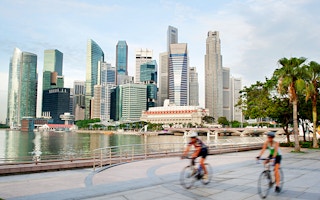Urban planning that prioritises the needs of cyclists and pedestrians is one of the main reasons why Copenhagen is Monocle magazine’s World’s Most Liveable City for 2013, said Professor Jan Gehl, guest speaker at a Centre for Liveable Cities lecture on Friday in Singapore.
To continue reading, subscribe to Eco‑Business.
There's something for everyone. We offer a range of subscription plans.
- Access our stories and receive our Insights Weekly newsletter with the free EB Member plan.
- Unlock unlimited access to our content and archive with EB Circle.
- Publish your content with EB Premium.
Gehl, an academic from the Royal Danish Academy of Fine Arts and founding partner of Gehl Architects, highlighted that Singapore is close to achieving a similarly high degree of liveability.
This is despite Singapore placing 15th on the magazine survey and recently ranking poorly on global indices that focus on other quality of life indicators such as income inequality and emotiveness, he pointed out.
Speaking on “People Oriented Strategies for City Planning” at the NTUC Auditorium, he explained that there is a new paradigm on safe and sustainable cities rooted in people’s access to mobility and social interaction.
He said the key to achieve this is by reorienting urban spaces away from the modern aesthetic of skyscrapers and wide roads, to a more human-centric approach that promotes cycling and walking.
Singapore, he noted, has a National Cycling Plan that increases connections between residential communities. He added he was “quite impressed” with the cycling infrastructure seen on his recent visit to the residential neighbourhoods of Tampines and Ang Mo Kio.
Tampines is Singapore’s first neighbourhood to have a cycling path network that connects residents to nearby amenities, while the Centre for Liveable Cities is currently undertaking a collaborative research project with the Urban Land Institute to generate ideas for a “model town for everyday walking and cycling”, with Ang Mo Kio as a study area.
“
Professor Gehl identified a combination of short bicycle trips integrated into public transport as the most viable option for Singapore’s hot and humid climate.
The city-state can develop this further following Copenhagen’s cycling and pedestrian-friendly measures, he added.
Copenhagen, which has a city-wide network of bicycle lanes, a train system that accommodates commuters’ bikes, and pavements that cut across side lanes, is an example of a comprehensive sustainable urban environment. Currently, 37 per cent of Copenhagen’s residents bike to work and the city aims to increase this number by 50 per cent by 2015, according to the city’s plan to become carbon neutral by 2025.
If 50 per cent of Copenhageners cycle to their places of work or study by 2025, this would reduce 40,000 tonnes of carbon dioxide per year compared to 2010, the plan noted.
Professor Gehl detailed how promoting cycling and walking has already helped alleviate traffic congestion in his home city, and how reducing the number of cars on the roads and giving priority to pedestrians and cyclists has made Copenhagen more inclusive to children and the elderly. These changes have also made the city more accessible to those who could not afford cars, and enabled residents to become healthier by encouraging active lifestyles.
These plans to enhance Copenhagen’s cycling and pedestrian infrastructure are part of a wider Green Mobility strategy which aims for 75 per cent of all journeys in Copenhagen to be made on foot, by bicycle or by public transport by 2025.
Singapore is not too far away from reaping similar benefits, the professor emphasised. Based on his observations from a visit to Tampines, which has extensive cycling path networks, the town was well connected and had stretches of urban greenery.
He acknowledged, however, that more could be done to increase the connectedness within towns. Professor Gehl identified a combination of short bicycle trips integrated into public transport as the most viable option for Singapore’s hot and humid climate. He also underscored how more could be done to help integrate cycling into the everyday commute.
One suggestion is to have the next fleet of trains designed to accommodate commuters’ bicycles even during peak hour, so as to enable individuals to incorporate short stretches of cycling into their daily commute to work.
Strong leadership and ground-up support for cycling were also identified as critical factors for making cities more liveable. Responding to an audience question on how to overcome behavioural barriers to transforming city planning, Professor Gehl shared that he had observed a trend in other city planning departments, wherein officials rolled out pro-cycling and pro-pedestrian initiatives despite initial reservations.
“They did it anyway, and the schemes tended to succeed in the long run”, he said.
Measures are already being taken to make Singapore a more cyclable and walkable city. Under the National Cycling Plan, the Urban Redevelopment Authority aims to increase the cycling network to more than 700 kilometres by 2030. The Land Transport Authority also has invested S$43 million to design and construct dedicated off-road cycling paths in seven HDB Towns, and built 2,000 signalised pedestrian crossings and close to 500 overhead bridges across the island to encourage cycling and walking as transport alternatives.










